By Edo Konrad, 972 .June 18, 2019
Newly-uncovered documents reveal how Israel established the ‘Professors Committee’ in the days following the Six Day War to devise policies to pacify the Palestinians and make them leave the West Bank and Gaza permanently.
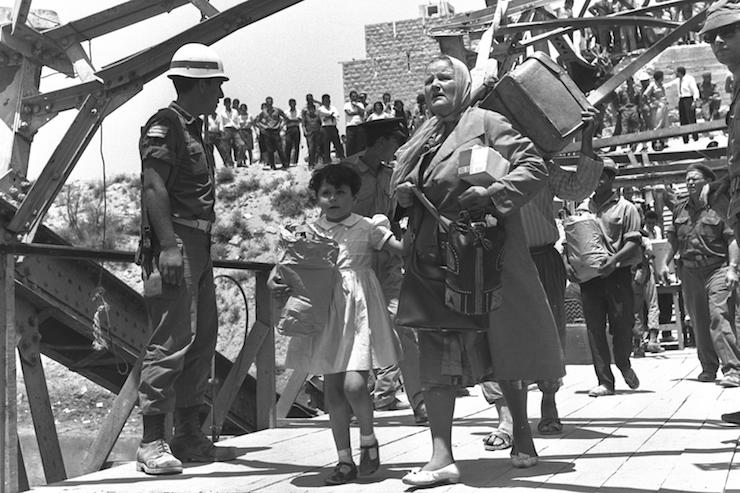
Palestinian families who fled to Jordan during the Six-Day War return to the West Bank through Allenby Bridge under an Israeli agreement with the Red Cross, July 18, 1967 (Teddy Brauner/GPO)
Mere weeks after nearly tripling the size of Israeli controlled territory in the 1967 Six-Day War, Israel enlisted teams of academics in the country to find ways to encourage Palestinians to emigrate from the newly occupied territories.
According to documents recently uncovered by by Omri Shafer Raviv, a PhD student in the Department of Jewish History at Hebrew University, in July 1967, then Israeli Prime Minister Levi Eshkol assembled a committee of academics including prominent Israeli sociologist Shemuel Noah Eisenstadt, economist Michael Bruno, demographer Roberto Baki, and mathematician Aryeh Dvoretzky — all of them with connections to the corridors of power — and sent them into the territories to study the newly-occupied population.
The objective of the “Committee for the Development of the Administered Territories,” referred to as the “Professors Committee” was, on paper, to create a body responsible for “long-term planning” in the occupied territories. The professors, along with their teams of researchers, were sent to villages, cities, and refugee camps to interview Palestinians about their lives, needs, and desires.
The second goal, says Shafer Raviv, was to better understand the Palestinians of the occupied territories in order to find ways to ensure they did not resist the military regime Israel placed them under — and which still rules them today — while looking for ways to encourage them to leave. “Those early years set the tone for how Israeli policy looks today,” he says.
The threat of modernity
When the war came to an end, says Shafer Raviv, the Israeli government had all kinds of goals vis-à-vis the Palestinian population, chief among them was to reduce the number of them living in the occupied territories. “We saw this most prominently in Gaza, where the authorities believed they could halve the population from 400,000 to 200,000 in order to contend with the new demographic problem.”
Most of the Palestinians in Gaza were refugees, and the government wanted to dismantle their refugee camps and encourage them to leave the country and be absorbed or integrate themselves elsewhere, Shafer Raviv explains. “That’s the context for Eshkol’s decision to establish the Professors Committee.”
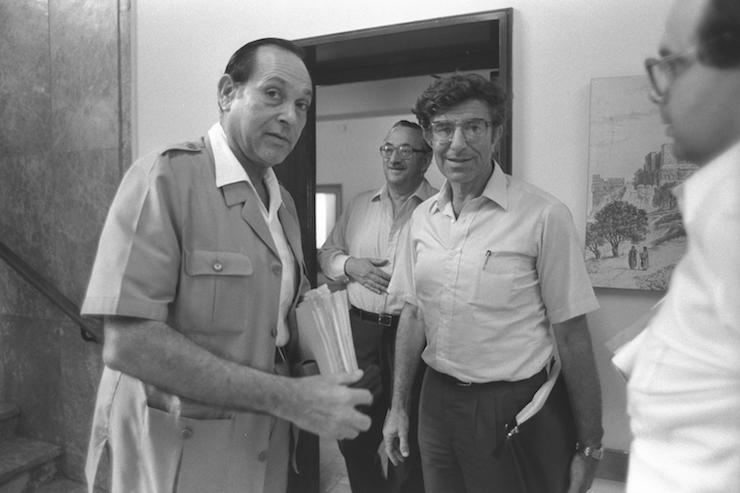
Economist Michael Bruno (second from right), who was part of the Professors Committee, seen leaving the Prime Minister’s Office in Jerusalem on June 30, 1985. (Herman Chanania/GPO)
The first few years after the start of the occupation saw a wave of popular, mostly nonviolent resistance to the occupation, including several mass strikes. There was also armed resistance by groups like Fatah, which sought to inspire Vietcong-inspired guerilla warfare against Israel. Another of the goals the Israeli government tasked the Professors Committee with was understanding how to limit popular resistance to Israeli rule, as well the extent to which revolutionary ideas such as communism or Palestinian nationalism could flourish in the occupied territories.
The academics, says Shafer Raviv, subscribed to a theoretical framework called “modernization theory” in order to analyze their empirical findings and formulate policy recommendations. The theory, which suggests that societies transition linearly from “traditional” to “modern,” was wildly popular among social scientists in the West, but hasn’t exactly stood the test of time. Critics accuse it of being too Western-centric and fundamentally incapable of accounting for the complex internal and external changes that affect groups and societies. Those theoretical blind spots would come to affect the work of the Professors Committee.
“The researchers made a distinction between the young people in the cities who tend toward secularism and education, and who are more inclined to take part in political activities, as opposed to the older generation who was far less interested in politics, more traditional, religious, and agrarian. The former was viewed as a threat, while the non-political lifestyle of the latter was to be encouraged,” Shafer Raviv says.
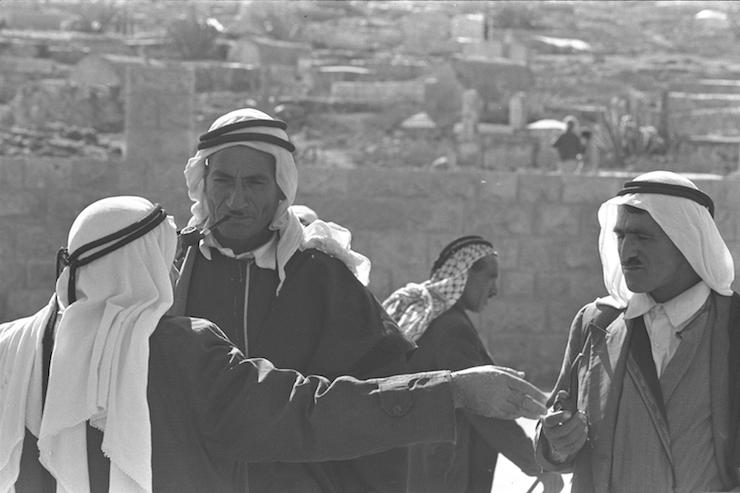
Palestinians seen in the West Bank city of Hebron, 1972. (Moshe Milner/GPO)
While Western social scientists were using modernization theory in an attempt to modernize societies as part of the effort to stave off communism, Israeli academics and officials took an inverse approach.
“When it came to keeping a civilian population under military rule, the modernization of Palestinian society went against Israeli interests,” Shafer Raviv adds. The Israeli government wanted to keep the occupied population pacified, and they believed that more they became modernized, the greater the threat of resistance.”
Among the questions that the Israeli researchers asked Palestinians were what they had for dinner, designed to classify whether they were “modern” or “traditional.” Large family dinners, for instance, were seen as traditional, whereas smaller dinners were a sign of modernity. This had consequences. Someone deemed more “modern” might more easily be suspected of being secular, and thus more inclined to hold nationalist or revolutionary politics.
Then there were straightforward political questions, especially in refugee camps: “Do you want to relocate to a new country? Why not? What would make you want to move? What is your solution to the refugee problem?”
One researcher, a political scientist, went to the Allenby Bridge border crossing in October 1967 and interviewed Palestinians as they left for Jordan. Many Palestinians were regularly crossing between the occupied Palestinian territories and Jordan, either for work or because their families lived abroad, Raviv explains.
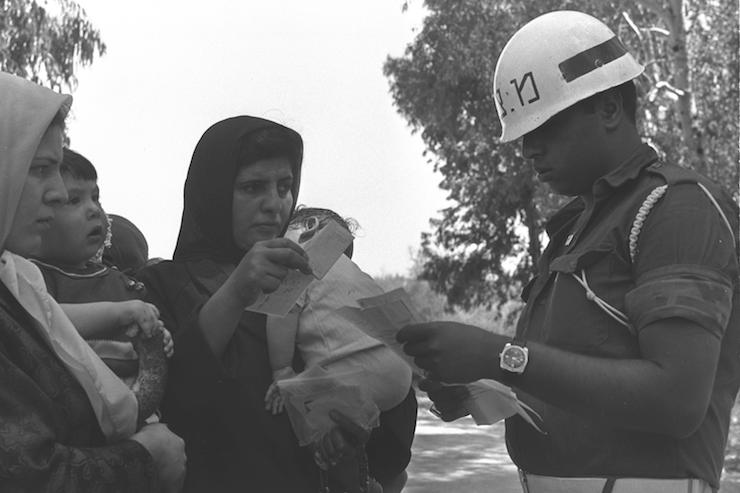
A military police officer inspects papers belonging to Palestinian women arriving from Jordan via Allenby Bridge, June 24, 1970. (Moshe Milner/GPO)
“He asked 500 people why they chose to leave, and those responses would later be handed over to the government so that it could better understand the reasons people were leaving,” Shafer Raviv says.
The Israeli academic, working with the permission of the Israeli army, concluded that Palestinians were leaving for Jordan for purpose of finding work or for family unification. “Under Jordanian rule, there was very little investment in the West Bank, so when the Israelis occupied it, there was simply not enough work,” Shafer Raviv says. “After the war the situation deteriorated even further in the West Bank. The Israeli government preferred to maintain high unemployment, seeing it as a good thing that would push people out to places like Jordan or Kuwait.”
Taking the experts by surprise
Shafer Raviv is part of a cadre of Israeli academics who have decided to focus their research on the occupation. While the New Historians such as Benny Morris and Tom Segev uncovered details of the 1948 war and the years after Israel’s founding that directly contradicted the Zionist narrative, this new batch of researchers has focused on the Israeli regime in the occupied territories.
Shafer Raviv’s study is the first of its kind, as it uses official government documents from the 1967 war and its aftermath that have only recently been declassified by both Israel’s National Archive and the IDF Archives.
Until the 1967 war, the central issue in the Israeli-Palestinian conflict was that of Palestinian refugees, who had been driven out of and fled from what became Israel, and whom Israel barred from returning to their homes following the 1948 war. With the end of the ’67 war, Israel found itself lording over many of those very same refugees who had fled to the West Bank and Gaza nearly 20 years earlier.
The Israeli government, says Shafer Raviv, viewed the 1967 occupation as an opportunity to solve the refugee problem on its own terms, either by encouraging the refugees leave on their own accord, or through an agreement with other Arab states. But when they began their research on the refugees, the professors discovered something that surprised them: the refugees were not interested in a political solution that did not include returning to their original land.
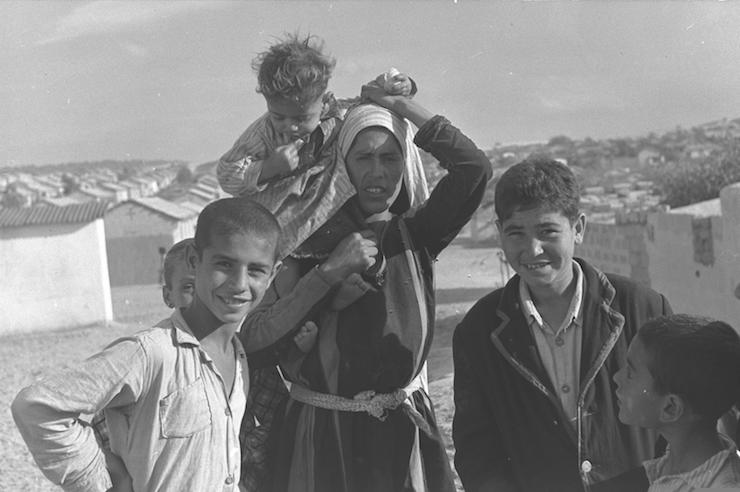
A Palestinian refugee family seen in a Gaza refugee camp, January 11, 1956. (Moshe Pridan/GPO)
“The researchers were under the impression that if the refugees could make a living and live comfortably in some place like Kuwait, there would be no reason for them to want to languish in a refugee camp in Gaza,” he explains. “Now the majority of refugees are telling them ‘No, we want to go back to what became Israel.’” This, of course, was a non-starter for the Israeli authorities.
The academics were further surprised to learn that the refugees had more “modern” characteristics than much of the rest of Palestinian society. “When they were forced into camps, refugees had to leave their agricultural pasts behind them, which meant that their children had no reason to learn how to work the land,” Shafer Raviv says.
Forced out of the lifestyle, customs, and agrarian economies of “village life” and into camps, the refugees had begun investing in their children’s education, as did UNRWA, the UN agency charged with running the refugee camps. All this, Shafer Raviv says, had far-reaching consequences: the percentage of first-generation refugees who were illiterate was around 70 percent, but that percentage dropped to nearly seven percent with the second generation raised in refugee camps.
The Professors Committee hoped to bolster these “modernization trends” among refugees. They believed that encouraging second generation refugees to receive an education and move to the city where they could realize their dreams would eventually lead to the dismantling of the refugee camps.
They understood that simply dismantling refugee camps and encouraging people to leave would lead to what they called “collective resistance.”
“The academics realized that to solve the refugee conflict, one cannot talk openly about solving the refugee conflict,” Shafer Raviv says. “You had to do things quietly — and what’s quieter than searching for an education or job opportunities in another country?”
The committee’s spirit lives on
Some of the other recommendations of the Professors Committee were at first counter-intuitive in their aims of encouraging emigration, and reducing the numbers of Palestinians living under Israeli control.
“One of the recommendations that was adopted by the Israeli government in December 1967 was to allow anyone who wanted to leave the occupied territories the option to return,” Shafer Raviv says.
“This was revolutionary; it went against the general the Israeli view adopted in 1948 that barred the return of people who left the country,” Shafer Raviv explains. “If you tell them ahead of time that they cannot return, they will never leave in the first place, since doing so would mean disconnecting from their family and their country.”
The Professors Committee published its initial findings in September 1967, although the first leg of its research was completed by February 1968 when it handed over its conclusions to Prime Minister Eshkol and held a number of conferences with officials from the military government, says Shafer Raviv.
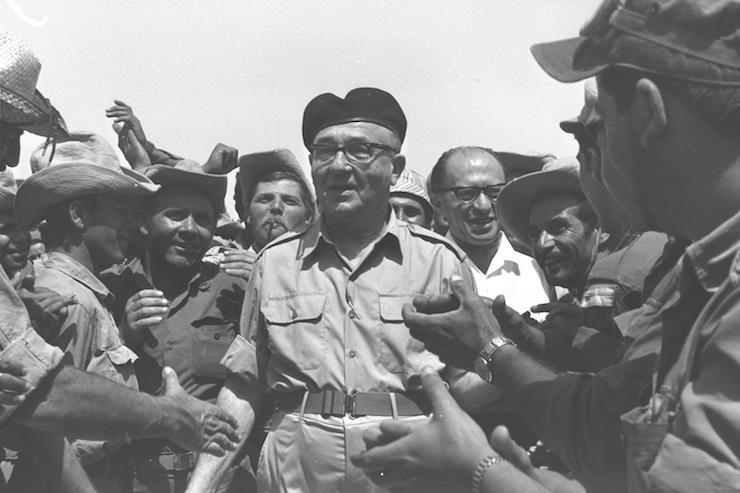
Prime Minister Levi Eshkol seen visiting an IDF reserves unit at Jebel Livni in the Sinai Peninsula, just days after Israel captured it from the Egyptians during the Six-Day War, June 14, 1967. (GPO)
A document from several years later includes a list of at least 30 studies on a range of issues such as the Christian population in the occupied territories, the economy of Nablus, and the possibility of marketing Israeli goods to Lebanon, among others. Those research projects continued well into the mid-1970s, at which point the paper trail disappears.
Shafer Raviv says that although we cannot be certain that the recommendations of the Professors Committee were ever directly translated into government policy — since the authorities also took into account other considerations, such as the opinions of the Shin Bet and the army — the spirit of their research certainly impacted decision-makers.
“There is no proof that recommendations were adopted solely on the basis of what the Committee proposed,” he says. “But one can see a connection between the recommendations and the policies. A prime example of this can be seen in the government’s decision to encourage Palestinian emigration.”
Edo Konrad is the editor-in-chief of +972 Magazine. Based in Tel Aviv, he previously worked as an editor for Haaretz.



972 is a far left antisemitic Jewish news site funded by the New Israel Fund. It promotes the canard that Israel is an Apartheid state. I would be skeptical of anything they would have to say about anything. Google: Wikipedia +972 magazine
One general came up with a plan to move the Gazans to a city in the Sinai that Israel would build for them after 1967. It was considered and turned down.
This shows how wrongly the government dealt with the aftermath of the war. After winning such an amazing victory , they completely dropped the ball. All the people in the West Bank, Judea and Samaria and Jordan Valley should have been relocated as part of the war effort to Jordan the day the war ended and the Gazans to Egypt. Arrange for reimbursement of losses after the relocation.Then instead of 53 years later and 4 million hostile people , the border would have been the Jordan river and Gaza would have been beautiful Mediterranean resort instead of a cesspool. It is still a mystery to me 53 years later how they got it so wrong. The Professors committee was a complete waste. A giant brake on progress at the moment of opportunity.